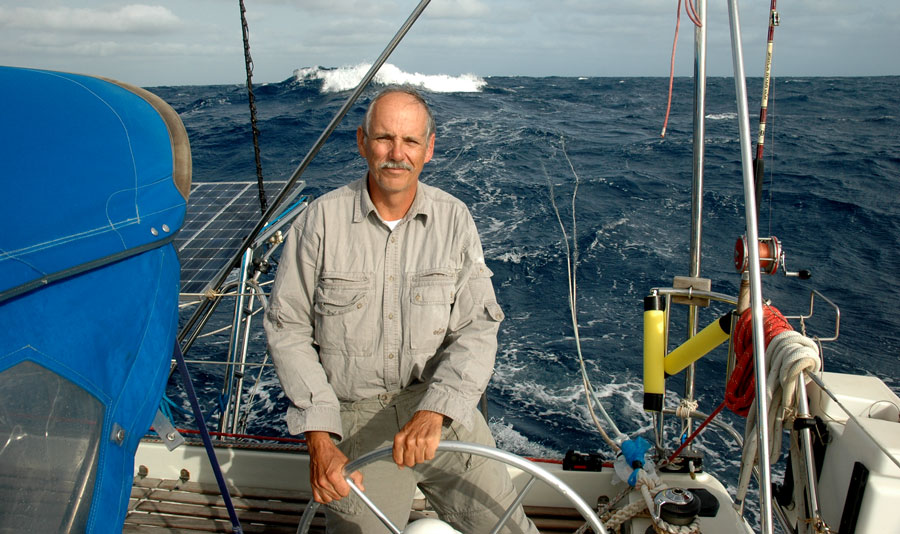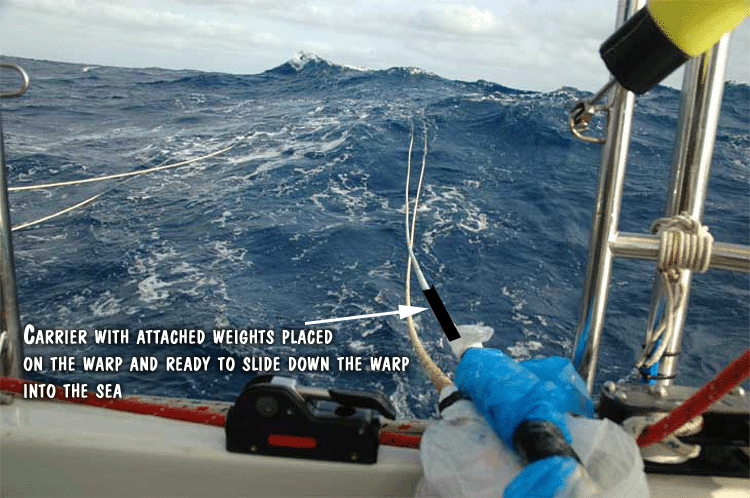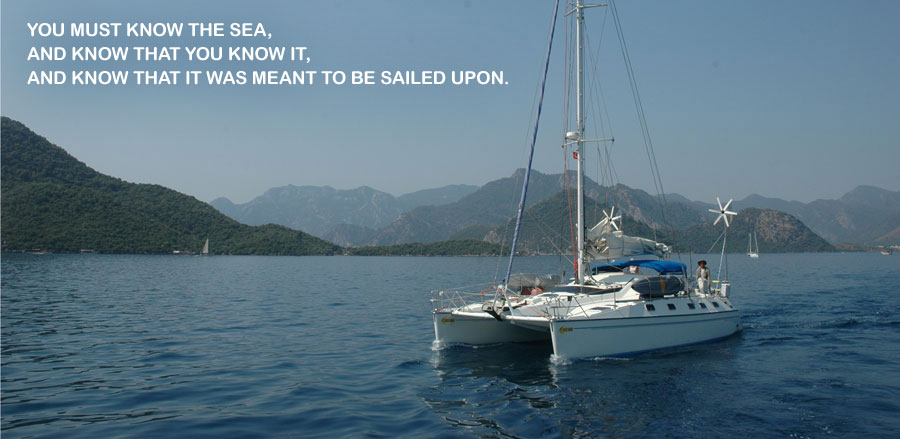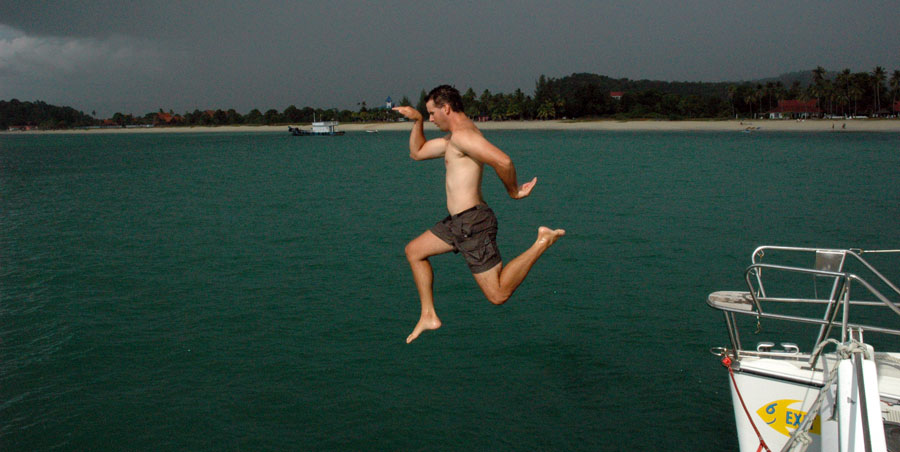SURVIVING THE SAVAGE SEAS
Once upon a time there was a small catamaran
named Exit Only. Although it wasn't a large yacht, it was big enough to
sail the seven seas - the reason was simple. Ninety-five percent of the
time the seas were small and the winds were light. In fact, in an
eleven year voyage around the world, Exit Only never saw winds in excess
of fifty knots while on passage, and only three or four times saw winds
up to forty knots.
That's the way it is for most boats who sail in temperate latitudes at
the correct time of year. People who sail for pleasure, rather than
necessity or racing, rarely find themselves caught out in a gale.
Nevertheless, sometimes mother nature throws you a curve and you get
caught in a storm, and that's exactly what happened to us as we ventured
out into the Atlantic from Gibraltar.
We
started our transatlantic crossing by sailing from Gibraltar to the
Canary Islands. Because this passage takes only five to six days, we
were able to select our weather window at the beginning of the trip, but
during the end of the passage the weather was up for grabs. We had no
reason to expect it would be bad, and no guarantee it would remain good.
As
the weather gods would have it, the last three days of the trip turned
into a gale with winds gusting to forty knots. Fortunately, the winds
were coming primarily from behind so we could run downwind.
Unfortunately, the seas rapidly became steep, up to twenty feet in
height, and there were cross seas as well, creating an exciting and
potentially dangerous ride.
Why
is it dangerous to sail downwind in gale force winds? Think for a
moment about the last time you saw a surfer wipeout going down the front
of a twenty foot wave. He has an awesome ride right up to the moment he
and his surfboard go berserk and get pulverized in the surf. Words like
pain and disaster pop into your mind as you watch the spectacular
wipeout.
Similar things can happen to a cruising yacht when it surfs down the
waves during a gale. When Exit Only started rocketing down those steep
twenty foot seas, our speed peaked at eighteen knots. Exit Only became
a giant surfboard that was forty feet long and twenty-one feet wide.
Surfing at ten knots was fun. Surfing at eighteen knots was getting
close to wipeout speed. If the autopilot lost control of the boat
during an eighteen knot surf, disaster could happen. Wipeout in a
cruising catamaran means flipping it over - a very expensive and painful
mistake - not to mention the fact the crew can get badly hurt in a
capsize. When your catamaran is upside down in the ocean, it becomes
the most expensive life raft on the seven seas.
Click on this button to
tell your friends about "Surviving The Savage Seas".


So
what do you do when things are getting out of control and you are
approaching wipeout conditions? The first thing to do is slow the boat
down by reducing sail. We had already done that. Our mainsail was
furled, and we had about ten percent of our headsail out to give us
enough sail power forward to keep our autopilot happy and make it easy
to safely steer the yacht downwind. That small handkerchief of sail
kept our boat pointed downwind, but it still gave us too much speed
which was getting out of control.
Taking our foot off the accelerator by reducing sail wasn't enough. We
needed to apply the brakes, and that's exactly what we did. Once we
turned on our boat breaks, our speed came down to five or six knots, and
peace and serenity returned to our chaotic water world.
What
exactly are boat brakes, and how do you apply them? Boat brakes are
drogues that you trail behind your boat to slow down. There are many
types of drogues, and you can trail them in many different
configurations.
The
main criteria for success in using drogues is they reduce your speed to
a safe level. You have enough speed for the autopilot to easily steer
the yacht, but you don't want to slow down so much that waves break on
the stern and fill your cockpit with water. Putting on boat brakes
isn't rocket science - just common sense.
Each
yacht behaves differently in following seas, and the number and type of
drogues you use depends on the design of the yacht. It's mostly trial
and error. The first drogue we put out consisted of eighty feet of one
inch three strand nylon rope with a ball of anchor chain attached to its
middle. We took fifteen feet of three-eighths inch chain and tied it in
knots and shackled it to a swivel in the middle of the rope bridle. We
then attached the two ends of the bridle to port and starboard winches
at the back of Exit Only. This first drogue had a modest effect in
slowing us down most of the time, but on the really big surfs, it didn't
give us enough drag.
We
put out a second drogue consisting of one-hundred and eighty feet of one
inch nylon line which formed a giant loop behind the boat, and we also
attached it to the winches at the back of the boat. This slowed us down
further, but still not quite enough. I increased the effectiveness of
this drogue by putting PVC hose on the line, and I shackled the dingy
anchor and chain to the hose. The PVC hose was a messenger that
transported the anchor and chain down the line, and carried it all the
way to the back of the one-hundred and eighty foot rope loop. This
additional weight kept the long loop of rope continually submerged and
substantially increased the effectiveness of the second drogue in
controlling boat speed. This was just right.
We
ended up trailing two drogues behind our boat. One loop trailed forty
feet behind Exit Only, and the other was eighty feet off our stern. The
weights on the drogues kept them submerged, and the different distances
of the drogues from the stern guaranteed that one of them was effective
when the other was slack. This combination of drogues snatched victory
from the jaws of defeat, and our worries were over.
If
the storm became worse, we would have deployed our Jordan Series Drogue
which consists of a two-hundred foot line with one-hundred and twenty
sailcloth cones attached to the line. That would have stopped us in our
tracks. Fortunately, we didn't need a drogue that powerful, so we
didn't use it. It was ready if we needed it, but thankfully, it wasn't
necessary.
These storm management techniques worked well for us because we are a
catamaran. The arms of the drogues were attached to winches that are
twenty feet apart on the stern, and that augmented the ability of the
drogue to create directional stability in the yacht. It also worked
well because a catamaran has a bridge deck, and when breaking seas
assault the stern of Exit Only, they pass under the bridge deck rather
than come into the cockpit. On a monohull yacht, the same techniques
might be less effective, and you might end up with water in the
cockpit. Every yacht behaves in a different manner when they trail
drogues in steep following seas. Several monohull yachts sailing in the
same gale ended up with water in their cockpit.
In
33,000 miles of sailing around the world, this was the first time we
ever needed to trail drogues behind our yacht. That should put things
in their proper perspective. If you sail the seven seas in a
conservative manner at the correct time of year, you have a ninety-five
percent chance of having a wonderful adventure, but five percent of the
time, things may unwind a bit, and you end up in a gale. When that
happens, you say, "No worries mate." You trail your drogues and control
your speed until the storm passes by. Then you continue on to your
destination and tell your friends about how you survived the savage
seas.
Boat brakes. I love them!

ABBOTT DROGUE - ADJUSTABLE
MEDIUM PULL DROGUE FOR WINDS TO FIFTY KNOTS
INEXPENSIVE
DROGUE THAT YOU CAN CONSTRUCT USING MATERIALS ONBOARD
Most storms at sea are not survival storms, and you don't need to
put out a parachute sea anchor or use a Jordan Series Drogue to
survive. What you need is help controlling your yacht in non-survival
conditions.
Even though most yachts don't experience survival storms, many still
get out of control and broach because they sail in an uncontrolled
manner. These yachts need something to slow them down and impart
directional stability to their vessel to remain in control in bad
weather.
On Exit Only, we use an ABBOTT DROGUE constructed of materials that
are readily available on board. We don't need to get out the Series
Drogue because the ABBOTT DROGUE HAS ENOUGH POWER to control our 39 foot
catamaran in winds up to fifty knots. In our eleven year
circumnavigation we never had winds in excess of fifty knots, and we
never had to use our Series Drogue.
The
ABBOTT DROGUE consists of one-hundred and eighty feet of one inch nylon
line which forms a giant loop behind the boat. We attach the loops to
the port and starboard winches at the back of the boat. We then slide
weights down the loop of rope to increase the drogue effect.
You can't slide weights down a warp without attaching them to a carrier
(to prevent chafe), and I use water hose as my carrier that transports
the weights down the warp. I slide a meter long piece of flexible
plastic water hose over the one inch warp , and then I shackle the dingy
anchor and chain to the water hose so that it's firmly attached , and it
cannot come off the hose carrier. The hose is the carrier that
transports the anchor and chain down the warp to the center of the
one-hundred and eighty foot rope loop. As soon as the carrier and
attached weight hit the water, they slide rapidly down the warp until
they reach the middle of the loop, This additional weight keeps the
warp continually submerged and substantially increases the effectiveness
of the warp in controlling boat speed. The irregular shape and heavy
weight of the chain and dingy anchor on the carrier creates turbulence
in the water increasing the power of the drogue.
The ABBOTT DROGUE has several advantages.
1. It is adjustable. You can winch the drogue in and out to
control its distance behind your yacht. If you want the drogue farther
out, let out more line. If you want the drogue closer to the yacht,
then winch it in. It's a good idea to vary the distance of the drogue
behind the yacht according the the sea state. You don't want the drogue
to pull out of the front side of a wave which would cause it to
instantly lose it's effectiveness. Instead, you want the drogue in the
middle or the backside of the wave where it will have maximum power.
This is easily done by adjusting the length of the rope loop.
2. The carriers stay centered in the middle of the rope loop where
it has maximum effectiveness.
3. You can vary the power of the drogue. You can send as many
hose carriers down the warp as you want. If you want to increase the
power of the drogue, then put more anchor chain on the hose carriers and
send a second or third carrier down the warp to the back of the loop.
4. It is chafe resistant. We normally use hose on our boat as
chafing gear for our dock lines. We use the same water hose as the
carriers to carry the weights out to the middle of the loop of rope. If
we are worried about chafe in a storm, we can take in or let out a
little more rope so that the position of the carriers on the warp shift
slightly reducing any chafe.
5. It's easily recoverable. When it comes time to pull in the
ABBOTT DROGUE, you simply winch it in. Because the hose carriers stay
centered in the middle of the rope loop, the carriers and attached
weights are easy to recover when they get to the stern of the yacht.
6. It's constructed of materials that you already have on board.
You don't need to spend a thousand dollars to have an ABBOTT DROGUE.
You simply use water hose for carriers, anchors and chains for weight,
and warps that you already have on board.
The ABBOTT DROGUE works well for us because
we are a catamaran. The arms of the drogues are attached to winches
that are twenty feet apart on the stern, and that augments the ability
of the drogue to create directional stability in our yacht. It also
works well because a catamaran has a bridge deck, and when breaking seas
assault the stern of Exit Only, they tend to pass under the bridge deck
rather than come into the cockpit. On a monohull yacht, the same
techniques might be less effective, and you might end up with water in
the cockpit. Every yacht behaves in a different manner when they trail
drogues in steep following seas.
An ABBOTT DROGUE isn't a Jordan Series Drogue, and it's not intended to
be used in survival conditions.
The ABBOTT DROGUE is a medium pull drogue intended for use in winds to
fifty knots. It's easily constructed in an emergency, adjustable, chafe
resistant, and inexpensive.
When we find ourselves in trouble offshore, but not in survival
conditions, we construct an ABBOTT DROGUE. If conditions deteriorate
further, then we call upon our Jordan Series Drogue or Parachute Sea
Anchor to keep us safe.
Life is good.

YOU MUST KNOW THE SEA
Joshua Slocum said, "You must know
the sea, and know that you know it, and know that it was meant
to be sailed upon." What Joshua was describing was a real
mariner.
True mariners are in short supply. There have never been so
many boats parked in marinas, and so few mariners to take them
out of the slip.
The ocean is a mariner factory. When you successfully weather a
storm at sea, you're one storm closer to becoming a true
mariner. Surviving a single storm at sea may not make you into
a mariner, but it's a step in the right direction.
Becoming a mariner takes time, because it requires years to get
to know the sea in all of its moods. You can't get to know it
from books. You can read about it all you want, but until you
experience it first hand, you won't understand the wiles of the
sea. You need to put thousands of miles in your wake before you
know the sea and know that you know it.
I've
been to seminars designed to prepare sailors for offshore sailing.
Seminars are good at teaching people what to do in an emergency, but
there's no seminar that can make you into a mariner. Only the sea can
do that.
Becoming a mariner is a catch-22 situation. You shouldn't go to sea
unless you are a mariner, and you can't become a mariner unless you go
to sea.
The wannabe mariner's dilemma isn't as bad as it first might seem.
Becoming a mariner is an incremental task, and most of all, you need
time at sea. There's no other way to become a mariner except by
slipping your dock lines and getting out on the high seas. The trick is
to not bite off more than you can chew early on in the process.
When I first set sail on my circumnavigation, I had never sailed
offshore at night. I was comfortable with the idea of sailing during
daylight hours, but night sailing was an entirely different matter. I
felt as if I was sailing blind and it made me uneasy. I had to start
thinking like a mariner about night sailing. I quickly discovered that
if I reduced sail and slowed the boat down at night, my distaste for
night sailing went away. Slowing down at night was one of the first
mariner-like lessons I learned on my trip around the world.
The sea has many lessons to teach, and if we pay attention, it won't be
long before we start behaving like mariners. Our sea legs will come,
and eventually we will learn to swashbuckle with confidence as we sail
the seven seas.
Knowing the sea, and knowing that you know it, isn't impossible, it just
takes time. If you are patient and put in the time, your confidence
will increase, and you will know that the sea was meant to sailed upon.
You will become a true mariner.

TAKE THE PLUNGE AND
ORDER THE
RED SEA CHRONICLES.
JUMP INTO A GREAT MULTIHULL CRUISING VIDEO. YOU WILL BE GLAD THAT
YOU DID!